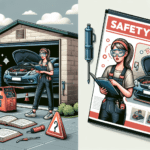Are you wondering about the difference between portable garages and carports? Well, look no further! In this article, we will break down this distinction for you in a friendly and straightforward manner. You’ll soon understand the unique features and advantages of each option, helping you make an informed decision for your vehicle protection needs. So let’s get started and unravel the mystery behind portable garages and carports.

Definition of Portable Garages
Portable garages are temporary, lightweight structures that are designed to provide shelter for vehicles, such as cars, motorcycles, and boats. They are typically made of a durable frame, often constructed from steel or aluminum, which is covered by a weather-resistant fabric. Portable garages can be easily assembled and disassembled, making them a convenient option for those who need temporary or mobile storage for their vehicles.
Features of Portable Garages
Portable garages come with several features that make them a practical choice for vehicle owners. Some of the key features include:
-
Durability: Portable garages are built to withstand various weather conditions, including rain, snow, and wind. The materials used in their construction are typically resistant to rust, corrosion, and UV rays, ensuring long-lasting protection for your vehicles.
-
Portability: As the name suggests, portable garages can be easily moved and transported. They are designed to be lightweight and often come with wheels or a carrying case, allowing you to relocate them as needed.
-
Versatility: Portable garages can serve multiple purposes. In addition to providing shelter for vehicles, they can also be used for storage of other items, such as tools, equipment, or outdoor furniture.
-
Easy Assembly: Most portable garages feature a simple and straightforward assembly process. They often come with a set of instructions and require minimal tools and effort to set up.
Advantages of Portable Garages
There are several advantages to using portable garages for vehicle storage:
-
Cost-Effective: Portable garages are generally more affordable than permanent traditional garages. They offer a budget-friendly option for vehicle owners who seek protection and storage without the high costs associated with constructing a permanent structure.
-
Flexibility: Since portable garages are not permanently attached to the ground, they offer the flexibility to be moved or disassembled whenever necessary. This is particularly beneficial for individuals who frequently change their residence or need temporary storage solutions.
-
Quick Installation: Unlike permanent garages, which may require extensive construction and permits, portable garages can be easily set up within a short period. This makes them a convenient solution for immediate vehicle storage needs.
-
Protection from the Elements: Portable garages provide a shield against the elements, protecting vehicles from harmful sun exposure, rain, snow, and other weather conditions that can cause damage.
Disadvantages of Portable Garages
While portable garages offer numerous advantages, it is important to consider their limitations:
-
Limited Longevity: Despite being durable, portable garages may not have the same lifespan as permanent structures. With prolonged exposure to harsh weather conditions, the fabric cover and frame may wear down over time and require replacement.
-
Limited Security: Portable garages might not offer the same level of security as permanent garages. They can be vulnerable to theft or unauthorized access since they are typically made of lightweight materials.
-
Size Constraints: Portable garages may have size restrictions that limit their capacity to accommodate larger vehicles or multiple vehicles. It is important to consider the dimensions and specifications of the portable garage when selecting one for your needs.
Definition of Carports
Carports are structures designed to provide shelter and protection for vehicles, similar to portable garages. However, carports differ from portable garages in terms of design and structure.
Features of Carports
Carports share some features with portable garages, but they also have distinct characteristics:
-
Open Design: Unlike portable garages, carports have an open design, featuring a roof supported by a framework without full sidewalls. This provides more ventilation and easier access to the vehicles.
-
Permanent or Semi-Permanent: Carports can be either permanently installed structures, attached to a building or the ground, or semi-permanent structures that are freestanding but can still be moved if necessary.
-
Variety of Materials: Carports can be constructed from various materials, such as metal, wood, or even fabric. The choice of material depends on factors such as climate, aesthetic preferences, and durability requirements.
Advantages of Carports
Carports offer several advantages for vehicle owners:
-
Cost-Effective: Carports are often more affordable than constructing a traditional garage. They provide a cost-effective way to protect vehicles from the elements without the expenses associated with a fully enclosed structure.
-
Versatility: Carports can be customized to fit different needs. They can be used not only for vehicle storage but also as covered outdoor spaces for gatherings or as shaded areas for outdoor work or hobbies.
-
Enhanced Ventilation: The open design of carports allows for better ventilation, reducing the risk of moisture accumulation and related issues, such as mold or mildew growth.
-
Easy Maintenance: Carports generally require less maintenance compared to traditional garages. With fewer walls and surfaces to maintain, cleaning and upkeep are often simpler and less time-consuming.
Disadvantages of Carports
Despite their advantages, carports also have some limitations:
-
Limited Protection: Unlike fully enclosed garages, carports provide limited protection from external elements. While they shield vehicles from direct sunlight and some precipitation, they do not offer the same level of security or protection against wind, hail, or theft.
-
Reduced Privacy: Carports being open-sided structures, do not provide the privacy that enclosed garages offer. This may not be a concern for everyone, but it is worth considering if privacy is a priority.
-
Vulnerability to Weather Conditions: The open design of carports makes them susceptible to strong winds, heavy rain, or snowfall. Depending on the material used and the region’s climate, carports may require additional reinforcements or regular maintenance to withstand harsh weather conditions.
Design and Structure
Portable Garage Design and Structure
Portable garages are typically designed with a lightweight frame made of steel or aluminum. This frame provides the structure and support for the shelter, while the cover is usually made of a strong, weather-resistant fabric. The frame is often assembled using connectors and fittings, allowing for easy setup and disassembly. The fabric cover is securely attached to the frame and can be tensioned to ensure a tight fit.
The design of portable garages varies, with options including peaked roofs for better snow shedding, rounded roofs for enhanced aesthetics, or even enclosed options that provide more security. Some portable garages also feature zippered doors or roll-up closures for easy access to the stored vehicles.
Carport Design and Structure
Carports typically consist of a roof supported by a framework of beams or columns. Unlike garages, carports do not have full sidewalls, which allows for improved airflow and visibility. The framework of carports can be made from metal, wood, or other suitable materials, depending on individual preferences and requirements.
The design of carports can vary significantly, ranging from simple single-vehicle structures to larger multi-vehicle carports. Carports can be attached to existing structures, such as houses or buildings, or they can be freestanding. Some carports may feature additional elements, such as lattice panels or decorative enhancements to match the overall aesthetic of the property.
Comparison of Design and Structure
When comparing the design and structure of portable garages and carports, two main differences stand out. Firstly, portable garages are fully enclosed structures with fabric covers, providing a secure and weather-resistant space for vehicles. Carports, on the other hand, have an open design that allows for more ventilation and easier access.
Secondly, portable garages are typically temporary or mobile structures that can be easily assembled and disassembled, while carports can range from permanent installations to semi-permanent or easily movable structures.
The choice between portable garages and carports ultimately depends on individual preferences, budget, and intended use.

Usage and Functionality
Uses of Portable Garages
Portable garages are versatile structures that offer various uses beyond vehicle storage. Some common uses include:
-
Vehicle Storage: The primary purpose of portable garages is to provide shelter and protection for vehicles, including cars, motorcycles, ATVs, boats, or RVs.
-
Equipment Storage: Portable garages can be used to store various equipment, such as gardening tools, lawn mowers, bicycles, or sports gear.
-
Workshop Space: With their sheltered and enclosed design, portable garages can be transformed into temporary workshop spaces. This allows for a protected working area for DIY projects, repairs, or crafting.
-
Event Shelter: Portable garages can serve as temporary shelters for outdoor events, providing cover from sun or rain for gatherings, parties, or vendors at fairs or markets.
Uses of Carports
Carports also offer a range of uses beyond vehicle storage:
-
Vehicle Protection: The primary purpose of carports is to protect vehicles from sun exposure, rain, or snowfall, maintaining their paintwork and prolonging their lifespan.
-
Outdoor Living Space: Carports can be transformed into covered outdoor living areas, providing shaded space for relaxation, socializing, or dining.
-
Vehicle Maintenance: Carports provide a suitable environment for performing basic vehicle maintenance tasks, such as washing, detailing, or minor repairs.
-
Storage for Outdoor Items: Carports can be used to store outdoor items, such as gardening equipment, bicycles, or seasonal decorations.
Comparison of Usage and Functionality
While both portable garages and carports offer vehicle storage solutions, portable garages tend to be more versatile in terms of usage. The enclosed design of portable garages allows for a wider range of applications, including equipment storage, workshop space, or temporary event shelters.
Carports, on the other hand, are primarily designed for vehicle protection. While they can still serve as shaded outdoor areas, their open design limits some of the additional uses that portable garages can offer. The choice between portable garages and carports depends on individual needs and preferences, considering factors such as the desired level of protection, flexibility, and potential alternative uses.
Installation and Mobility
Installation of Portable Garages
One of the notable advantages of portable garages is the ease of installation. The process typically involves the following steps:
-
Site Preparation: Select a suitable location that can accommodate the size of the portable garage. Ensure the ground is level, free from debris, and appropriately prepared to provide stable support.
-
Frame Assembly: Start by assembling the frame of the portable garage according to the manufacturer’s instructions. Connect the frame components using fittings or connectors, ensuring a secure and stable structure.
-
Cover Attachment: After assembling the frame, attach the fabric cover securely. The cover may feature hook and loop fasteners, tension systems, or zippers to ensure a tight fit. Follow the manufacturer’s guidelines to properly attach the cover.
-
Anchoring: To enhance stability and resistance to wind, anchor the portable garage to the ground. This may involve using stakes, augers, or weights, depending on the specific anchoring system provided with the portable garage.
Installation of Carports
The installation of carports can vary depending on the design and type of carport chosen. Here are the general steps involved:
-
Evaluation and Planning: Assess the desired location for the carport, considering factors such as space availability, proximity to the house, and required permits or regulations. Make sure the chosen area is suitable for the size and design of the carport.
-
Foundation Preparation: Depending on the selected carport type, prepare the foundation as required. This may involve pouring a concrete pad, setting posts, or attaching the carport to an existing building.
-
Framework Assembly: Begin assembling the framework of the carport, following the manufacturer’s instructions. Depending on the materials used, use appropriate tools and techniques to connect the beams or columns securely.
-
Roof Installation: Once the framework is assembled, install the roof of the carport. This may involve attaching panels, fabric, or other suitable materials to provide weather protection and shading.
-
Finishing Touches: Check for any loose connections or areas that require additional reinforcement. Ensure the carport is level and stable, and make any necessary adjustments or additions to enhance its durability and functionality.
Mobility of Portable Garages
One of the key advantages of portable garages is their mobility. They can be easily moved or transported to a different location. The level of mobility depends on factors such as the size, weight, and specific design features of the portable garage.
Portable garages designed for easy mobility often come with wheels or a carrying case, allowing for convenient transportation. Some portable garages can be dismantled into smaller components, making them easier to fit into a vehicle or store when not in use.
Mobility of Carports
Carports, especially permanent installations or those attached to existing structures, are not as mobile as portable garages. However, certain types of carports, such as freestanding or semi-permanent ones, can still be moved if necessary. This mobility is typically achieved by detaching the carport from the ground or disconnecting it from any attached structures.
It is worth noting that moving a carport requires careful planning, as it may involve disruption to the foundation or structural components. It is advisable to consult the manufacturer’s instructions or seek professional assistance when considering relocating a carport.
Materials and Durability
Materials Used in Portable Garages
Portable garages are constructed using various materials to ensure durability and weather resistance. The key materials used in their construction include:
-
Frame: The frame of portable garages is typically made from steel or aluminum. These metals provide strength, stability, and resistance to rust and corrosion. The choice between steel and aluminum depends on factors such as weight, cost, and specific requirements.
-
Cover Fabric: The cover of portable garages is usually made from a durable, high-density polyethylene (HDPE) fabric or a similar weather-resistant material. This fabric is designed to withstand UV rays, water, and wind, while also providing adequate ventilation.
Materials Used in Carports
The materials used in carports can vary depending on the intended design and durability requirements. Here are some commonly used materials:
-
Metal: Steel is a popular choice for carport frames due to its strength, durability, and resistance to rust and corrosion. Galvanized steel is often used to enhance its lifespan. Aluminum carport frames offer similar benefits but with the advantage of being lightweight.
-
Wood: Carports can also be constructed using wood for a more natural and aesthetically pleasing look. Wood carports require regular maintenance to protect against rotting, warping, and insect damage. Treating the wood with appropriate sealants can help prolong its lifespan.
-
Fabric: Some carports feature fabric covers made of materials such as polyethylene or polyester. These covers provide UV protection and some level of weather resistance. However, fabric carport covers may have a shorter lifespan compared to metal or wood.
Durability of Portable Garages
Portable garages are designed for durability, capable of withstanding various weather conditions. The materials used in their construction, such as steel or aluminum frames and weather-resistant fabric covers, contribute to their durability.
However, the longevity of portable garages can depend on factors such as the quality of materials used, the frequency of use, and exposure to extreme weather conditions. Regular maintenance, such as cleaning the covers, checking for any tears or damage, and ensuring proper anchoring, can help prolong the lifespan of a portable garage.
Durability of Carports
The durability of carports depends on the materials used and the level of maintenance provided. Here are some considerations:
-
Metal Carports: Steel or aluminum carports are generally durable and resistant to rust and corrosion. Galvanized steel offers enhanced protection against the elements. Proper maintenance, such as inspecting for any signs of damage or wear, can help ensure long-lasting durability.
-
Wood Carports: Wood carports require regular maintenance to ensure durability. Treating the wood with appropriate sealants and protecting it from moisture and insects is essential for extending its lifespan.
-
Fabric Carports: Carports with fabric covers may have a shorter lifespan compared to metal or wood. The fabric cover may require periodic replacement or repair to maintain its durability and effectiveness.
Regular care, such as cleaning, removing debris, and inspecting for any potential issues, can help maximize the durability of carports regardless of the material used.
Protection and Security
Protection Offered by Portable Garages
Portable garages provide various levels of protection to vehicles and stored items. Some key aspects of protection offered by portable garages include:
-
Weather Protection: Portable garages shield vehicles from the harmful effects of sun exposure, rain, snow, and strong winds. The weather-resistant fabric covers provide a barrier against moisture and harmful UV rays.
-
Security from Theft: While portable garages may not offer the same level of security as fully enclosed garages, they can still deter theft and unauthorized access. The fabric cover can be closed and locked, making it more difficult for potential thieves to gain access to the stored vehicles.
-
Vehicle Privacy: Portable garages provide some level of privacy by covering the vehicles and limiting visibility from the outside. This can be beneficial for those who prefer not to have their vehicles on full display.
Protection Offered by Carports
Carports offer certain levels of protection for vehicles and provide other advantages as well:
-
Sun and Weather Protection: Carports shield vehicles from direct sunlight, helping to prevent damage caused by UV rays, such as fading or cracking of paintwork or interiors. They also provide partial protection from rain, snow, or hail, reducing exposure to moisture and its potential consequences.
-
Ventilation: The open design of carports allows for better airflow, reducing the risk of moisture accumulation and mold formation.
-
Accessibility: Carports offer easy access to vehicles compared to fully enclosed garages. Their open sides make it convenient to enter and exit the vehicles without maneuvering within confined spaces.
Comparison of Protection and Security
When comparing the protection and security offered by portable garages and carports, there are some key differences.
Portable garages provide a higher level of protection and security due to their fully enclosed design. The fabric covers provide enhanced weather protection and a deterrent against theft. However, it’s important to remember that portable garages are not as secure as permanent garages with solid walls and locked doors.
Carports, while offering protection against sun and weather elements, have open sides, making them less secure compared to fully enclosed garages or portable garages. However, carports still offer a valuable level of protection against weather damage and provide easy accessibility to vehicles.
Choosing between portable garages and carports for protection and security depends on individual needs, priorities, and the level of security required for the vehicles or stored items.
Cost and Affordability
Cost of Portable Garages
Portable garages are generally more cost-effective compared to permanent traditional garages. The specific cost can vary depending on factors such as size, materials used, and additional features. However, portable garages are typically priced lower than permanent garages due to their temporary and lightweight design.
The cost of a portable garage can range from a few hundred dollars for smaller, basic models to a few thousand dollars for larger, more advanced options. It is important to consider the overall value, durability, and features when assessing the cost of a portable garage.
Cost of Carports
Carports are generally considered more affordable than fully enclosed garages. The cost of a carport depends on various factors, including size, material, design complexity, and any additional features.
Metal carports are often more cost-effective compared to wood carports, as metal is generally less expensive and requires lower maintenance costs. The cost of a carport can range from a few hundred dollars for a basic single-vehicle structure to several thousand dollars for a larger, multi-vehicle carport with custom features.
It is worth noting that the cost of installation and any additional customization, such as lighting or additional storage space, can add to the overall cost of a carport.
Comparison of Cost and Affordability
Both portable garages and carports provide cost-effective alternatives to permanent garages. However, the cost comparison depends on various factors, including size, materials used, and desired features.
Portable garages tend to be more affordable due to their temporary and lightweight design. They offer a budget-friendly option for vehicle owners who require instant and cost-effective shelter.
Carports, while still considered more affordable than permanent garages, can have a higher initial cost compared to portable garages. The cost can vary based on the size, material, and customization options.
The decision between portable garages and carports should consider both the initial investment and the long-term value. Evaluating factors such as durability, versatility, and functionality can help determine the most cost-effective option for individual needs.
Permits and Regulations
Permits for Portable Garages
The need for permits for portable garages can vary depending on local regulations and the intended use of the structure. In some areas, permits may be required for temporary or permanent structures, regardless of size or purpose.
It is important to check with the local zoning department or building permit office to determine if a permit is necessary for placing and using a portable garage. They can provide information on specific requirements, such as setback distances from property lines or restrictions on the duration of temporary structures.
Complying with local permit regulations ensures that the portable garage is installed and used according to legal requirements, avoiding potential penalties or removal orders.
Permits for Carports
Similar to portable garages, permits for carports can vary depending on local regulations. The need for permits may depend on factors such as the size of the carport, whether it is attached to a building or freestanding, and how it will be used (temporary or permanent).
It is crucial to consult with the local building permit office or zoning department to determine if a permit is required for the installation of a carport. They can provide specific information on any size limitations, structural requirements, or setbacks that must be followed to comply with regulations.
Obtaining the necessary permits ensures that the carport is constructed and used in accordance with local regulations, minimizing any potential legal issues.
Regulations to Consider
In addition to permits, there may be other regulations to consider when installing portable garages or carports. These regulations can include:
-
Association Rules: Homeowners’ associations or community guidelines may have specific restrictions or regulations regarding the installation or appearance of portable garages or carports. It is important to review these rules to ensure compliance.
-
Setback Requirements: Setback requirements define the distance that structures must maintain from property lines, neighboring buildings, or other designated areas. Knowing and adhering to setback requirements is crucial to avoid violating local regulations.
-
Electrical or Plumbing Regulations: If the portable garage or carport will be used for purposes that require electrical or plumbing connections, additional regulations and permits may be necessary. Consult local authorities and professionals to ensure compliance with any electrical or plumbing codes if needed.
Consulting with local authorities, understanding neighborhood regulations, and ensuring compliance with any relevant regulations are essential steps in the installation and use of portable garages or carports.
Comparison of Permits and Regulations
Both portable garages and carports may require permits or compliance with regulations depending on local laws and regulations. However, the specific requirements can vary significantly from one jurisdiction to another.
The need for permits typically depends on factors such as the size, duration, and intended use of the structure. It is important to research and follow the regulations specific to the installation and use of portable garages or carports in the respective area.
Consulting with local building permit offices, zoning departments, or homeowners’ associations can provide the necessary information to ensure compliance with permits and regulations.
Factors to Consider
Deciding Factors for Portable Garages
When considering portable garages, several factors should be taken into account before making a decision:
-
Intended Use: Determine the primary use of the portable garage. Will it be solely for vehicle storage, or are you also looking to use it for other purposes such as equipment storage, a workshop, or temporary event shelter?
-
Size and Capacity: Assess the space required to accommodate your vehicles or any other items you are planning to store. Consider both the length and height of the portable garage to ensure it can comfortably accommodate your needs.
-
Durability and Weather Resistance: Evaluate the materials used in the construction of the portable garage and ensure they are durable, weather-resistant, and capable of withstanding the specific climate conditions in your area.
-
Security and Protection: Consider the level of security and protection needed for your vehicles or stored belongings. If security is a concern, look for portable garages with additional features such as lockable doors or reinforced frames.
-
Budget: Determine your budget for the portable garage, including any necessary installation costs or additional features. Compare prices, features, and warranties to find the most suitable option within your budget.
Deciding Factors for Carports
When considering carports, the following factors should be taken into consideration:
-
Shelter Needs: Assess your shelter needs, primarily focusing on protection from the elements. Consider the level of sun exposure, rainfall, or other weather conditions prevalent in your area.
-
Size and Design: Determine the size required to accommodate your vehicles comfortably. Evaluate different carport designs and customization options to find the one that best matches your aesthetics and functional requirements.
-
Material Selection: Consider the advantages and disadvantages of different carport materials, such as metal or wood. Evaluate factors such as cost, durability, maintenance requirements, and the overall aesthetic impact.
-
Installation and Permits: Make sure to consider any potential installation requirements, permits, or regulations specific to carports in your area. This includes setbacks, height restrictions, or association rules that may influence your choice.
-
Budget: Set a budget for your carport and consider the long-term value it provides. Compare prices, quality, and warranties to find the most cost-effective option that meets your needs.
Comparison of Factors to Consider
Comparing the factors to consider for portable garages and carports can help determine the most suitable solution. The primary differences to consider when comparing these factors are:
-
Versatility: Portable garages offer more versatility due to their enclosed structure, allowing for multiple uses beyond vehicle storage. Carports, with their open design, are primarily focused on providing shelter for vehicles.
-
Durability and Security: Portable garages offer higher durability and security due to their fully enclosed structure. Carports, with their open sides, have limitations in terms of protection and security.
-
Mobility: Portable garages are designed with mobility in mind, offering easy assembly, disassembly, and transportation. Carports, particularly permanent installations, are less mobile but still offer some flexibility for relocation if necessary.
-
Cost: Portable garages tend to be more affordable due to their temporary nature and lightweight design. Carports can have a higher initial cost but may provide better value over time, depending on the material and customization options chosen.
When comparing these factors, it is crucial to weigh the benefits and limitations of each option against individual needs and preferences. Considering factors such as specific usage requirements, level of protection needed, budget constraints, and local regulations will help make an informed decision between portable garages and carports.







